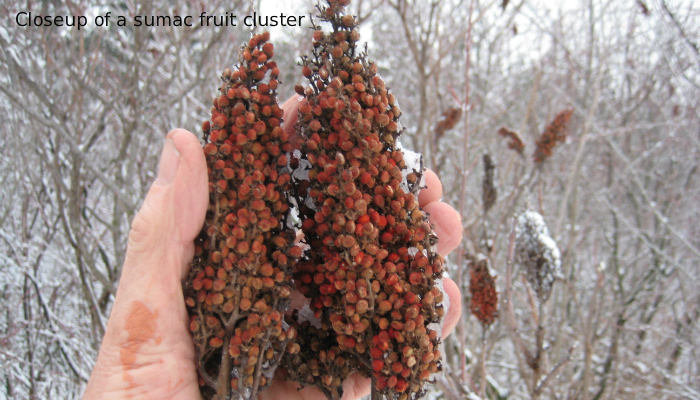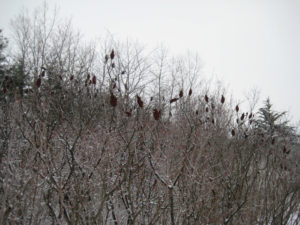Survival Food for the Birds
As we slipped into spring this year, native survival foods for the birds again played an important role. The robins, mourning doves, cedar waxwings, and others who had been working their way north, again found themselves stranded in repeated little snowstorms covering the ground and their food supplies. Most of our native trees and shrubs make their fruit and seeds available to wildlife as soon as it is produced in autumn; and that is long gone by late winter. But there are important exceptions:
A few species of fruits are initially almost inedible in autumn, being strongly laced with tannins and/or organic acids. But as with some of the things we consume, like tea and pickles, tannins and acids are good preservatives, which combined with outdoor refrigeration, prevent spoilage. And over winter the repeated freeze/thaw cycles gradually break down the preservatives, and the berries and seeds become more edible. These are the foods that now become available for the late winter migrants, when autumn’s abundance is a faded memory.
Some of our best examples of late winter survival foods for the birds include:

-
- Staghorn Sumac – it’s acidic little fuzzy fruit hangs on all winter as pyramidal clusters, becoming important to both songbirds and gamebirds from February through April.

A sumac colony growing in a sheltered valley behind a pine grove windbreak. According to American Wildlife and Plants by Martin, Zim, and Nelson, 38 species of USA birds eat the seeds of assorted sumac species.
- Highbush Cranberry – native to the Great Lakes ecosystem with its range extending into northeast Iowa, perhaps as far south as Strawberry point. It’s used in landscaping around here, where occasional individuals are found in nearby woods.
- Red Cedar – see my recent blog on this species: Red Cedar: Native Conifer Birds Love
- Native Bittersweet
- Various Hawthorn species or varieties
- Decorative crabapple varieties – while not native, some of these varieties also keep tiny apples over winter.
- Staghorn Sumac – it’s acidic little fuzzy fruit hangs on all winter as pyramidal clusters, becoming important to both songbirds and gamebirds from February through April.
So if you have a bit of space available in your yard or acreage, consider planting a survival food thicket for the returning migrants. Selecting a sheltered location, out of the winter wind, will make this planting more valuable to the birds. While it is one of the best survival foods, staghorn sumac needs a lot of space. In full sun and with good drainage, a little patch could sucker out to fill a small backyard over a decade.


